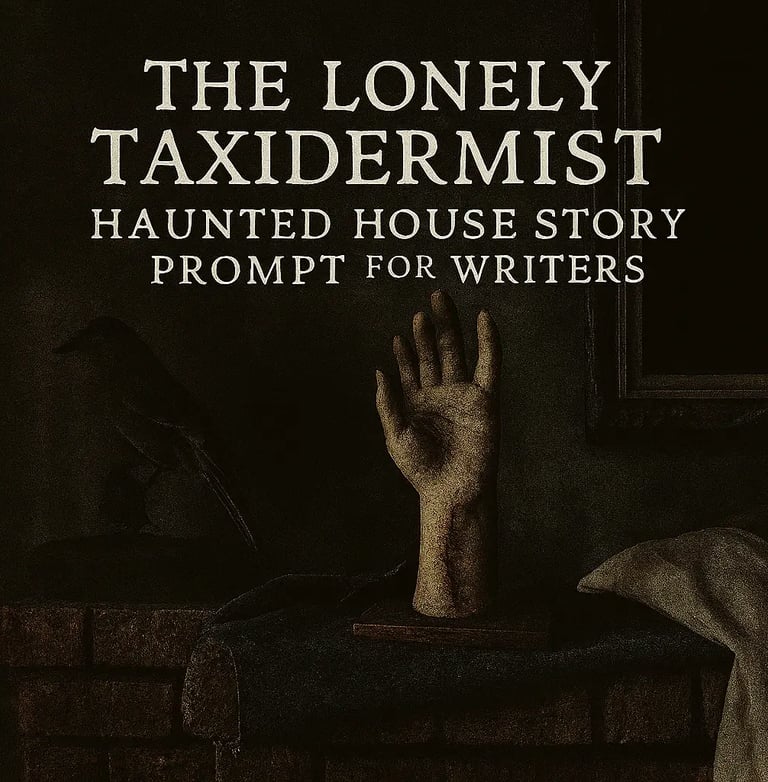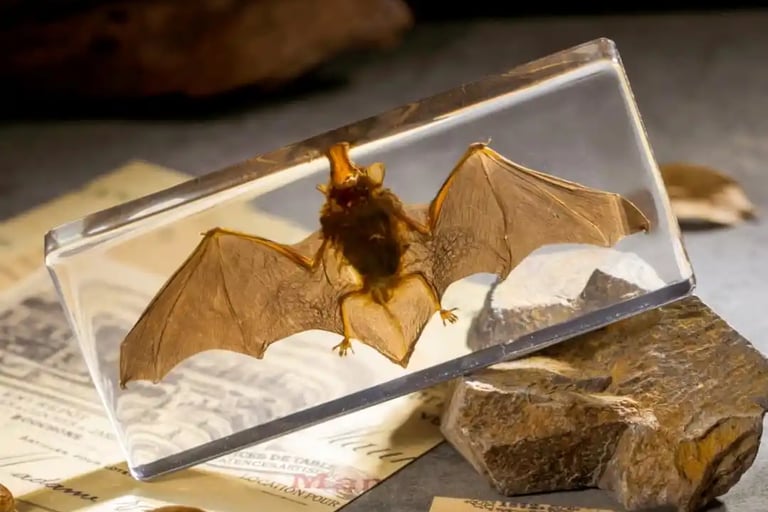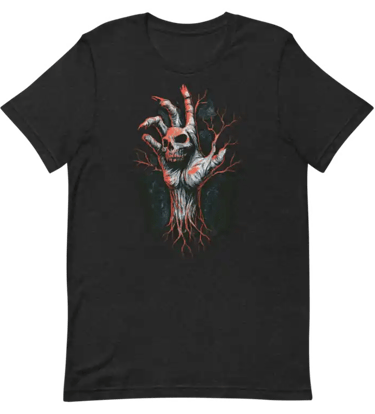Lonely Taxidermist Story Prompt
Explore The Lonely Taxidermist Haunted House Story Prompt — a lonely taxidermist story prompt with a mysterious trunk, a ledger, and captivating scene seeds.
TERRIFYING STORIES
Marcel Helmar
10/7/202517 min read


Caption: A preserved hand on the mantel, the house remembering what it once held.
The Lonely Taxidermist Haunted House Story Prompt
If you typed the lonely taxidermist haunted house story prompt for writers into a search bar, you were not looking for a how‑to so much as a bone‑cold invitation — an object with a history and a room that remembers the hands that tended it. The workshop smells of pine pitch and old linen; moth wings dust the windowsill like tiny verdicts. In this story the craft is the compass: stitches enumerate memory, glass eyes hold arguments, and the mantel keeps its ledger of small violences and tender repairs.
Here, the taxidermist is not a monster and not quite a saint. He is someone who counts stitches the way others count prayers, who treats skin and feather like archival language, who understands that to preserve is sometimes to summon. The house wants company; it has kept its hunger polite and well‑lit until now. Your prompt lives in the margins of a receipt tucked under a trunk lid, in the pattern of a child’s bonnet, in the slight give of a paw when you pick it up. Start with that tactile clue, and let the rest be things your hands remember before your mind does.
The Trunk Arrival
The knock comes at dusk, a single, polite percussion that sounds like someone closing a book from the other side of the house. He opens the door to an old couple who smell of cold kitchens and the slow sweetness of curing wood. They do not cry; they have already folded that work into neat parcels. From the back of the car they lift a trunk wrapped in a wool blanket and set it on his stoop as if placing a final, awkward chair in a room that has no room left.
Inside the trunk is a bonnet the color of tea, a child’s mitten stiff with time, a small paw wrapped in brown paper and twine. A ledger falls loose beneath the blanket — a slim book scored with a neighbor’s hand, ink smudged like dried sap. He opens it in the shop under the lamp and finds calm lists: stitches, adhesives, measurements. Between them, a different hand has annotated dates and initials and a repeated, scrawled glyph that looks like a parenthesis swallowing a seed. The annotations are not carelessness; they are insistence.
He props the trunk on the workbench of ancient technology and arranges the items in a ritual geometry that has been his private habit for years: mitten at ten, bonnet at two, paw at six, ledger upright against a jar of pins. The taxidermist rolls his sleeves and the room smells fuller for it — horsehair, glue warmed into a thin sweetness, the faint iron of old blood. He lays a scrap of linen beneath the paw and draws a needle through its tiny seam, counting stitches aloud because the sound gives rhythm to doubt.
The first nights are small disturbances. A drawer left closed will be found open; a tin of pins will cede two pins arranged into a tiny ladder; the kettle whistles a different note at two in the morning. He blames his clumsiness and his bad memory, until he does not. One morning he finds the bonnet hung on the peg by the door, though he remembers placing it on the bench. The bonnet’s ribbon is tied in a knot he does not tie. It is a small thing, the sort of quiet trespass that might have been a slip, a draft, a misremembered action — except for the ledger, which is now open to a page he did not himself turn to.


Display‑ready preserved specimen safely embedded in crystal‑clear resin.
The Lonely Taxidermist recommended prop: a preserved specimen in clear resin
$20.99
Stitch and Memory
He pins the bonnet to the lamp’s shade and works by the thin, steady light, as if the lamp itself were a witness sworn to silence. The bonnet’s fabric smells faintly of tea and something older, a lavender that has been steeped too long. He eases the stuffing out of the mitten and finds, beneath the brittle wool, a scrap of paper folded three times. The paper is a note that names a day and then nothing else, the kind of omission that reads like a promise withheld.
Stitching becomes a slow liturgy. He rigs a curved needle and drags horsehair through the skin, the thread pulling a little seam of sound from the room. Each stitch is an accounting: one for the bonnet, one for the mitten, one for the paw. His fingers know the shape of the motion without his mind’s consent; the muscles contract and release, counting in the same rhythm as the ledger’s marginal glyphs. Sometimes, when the thread catches, he feels a small, polite tug from the bench, as if the house is checking the tautness of his work.
Memory arrives in fragments: the smell of oat porridge cooling on a sill, a child’s laughter that refuses to be more than a single breath, the tilt of a rocking chair that never quite stopped. The paw, wrapped in its linen, makes a sound like a dry blossom being pressed between pages. He unrolls it on the cloth and the paw seems to lie there with purpose, neither pleading nor inert, an object that carries refusal as calmly as an heirloom carries dust.
He reads the ledger’s ink like a map. Between lists of sizes and adhesives someone has scribbled instructions in shorthand: feed the hollow with bread; do not let the bonnet touch flame; count the stitches thrice and then once more to close. The annotations are not warnings so much as the economy of a household trying to buy time. He obeys them because they are the only directions he understands that fit the shape of the room.
At night the shop breathes differently. The jars settle in their nests; the pins that have no business moving rearrange themselves into patterns that resemble letters. Once, he wakes with the taste of iron in his mouth and the memory of a small footfall on the back stairs. He tells himself these are the work’s residue, the residue of paying attention for too long, and yet he starts to dream of the paw: how, in the dark, it flexes toward the shape of a hand.
Feeding the Hollow
He learns the house in the way a reader learns a book by the smell of its margins. The small disturbances become sentences: a cup left half‑full on the windowsill, the kettle that sings a key he does not know, a scrap of newspaper folded into the shape of a child’s shoe. At first he tells himself these are the effects of two clocks out of time and a tired body doing the work of an honest profession. Then the bread appears.
It is always a thin slice, crust browned as if toasted by someone else’s mercy, set on the mantle between a cracked figurine and a jar of pinheads. He does not put it there; he finds it there in the morning, the scent of yeast embarrassed into the room. When he touches the crumb it leaves a faint dust like ash on his fingers. He eats half in the shop as if testing the proof of a thing, and the taste is not quite bread but memory warmed into a shape he almost recognizes.
At dusk he begins leaving small offerings by habit, little acts of bookkeeping that feel dangerously like prayer. A feather tucked under the bonnet’s ribbon. A scrap of linen folded into the paw’s palm. Once, on a night thick with rain that made the gutters breathe, he sets a copper bowl of warm water on the workbench and dips a finger, letting the water trace the seam of the paw as if sewing a seam with the tip of his touch. The water smells of tin and old pennies. The house answers by laying a finger of light across the ledger, landing on a line he did not read.
These are not dramatic hauntings. They are the polite things a house uses when it asks for attention: a chair angled slightly toward the workbench, a curtain that parts to show the street’s empty shape, a lullaby that begins on the radio and ends without a chorus. But each small concession draws him closer to the ledger’s arithmetic. The glyph repeats itself in the margins like a footnote: count, close, remember. He begins to hear the glyph as a cadence, a rhythm that fits the motion of his hands.
One night a child’s laugh slips down the stairwell and the lights dim in a slow, patient nod. He does not go to the attic for a reckoning; instead he takes a needle and with the lamp between his knees he stitches a tiny hole closed on the mitten, fingers moving in a choreography that feels less like repair and more like a litany. The stitches hold, and for a breath the room seems to unhand its hunger and remember the shape of ordinary tasks.
Afterwards, while the rain is still running in tatters down the glass, he writes, in his own cramped hand, a line beneath the ledger’s instruction: If you keep it tidy, the house will keep you company. He does not know whether he intends the sentiment as comfort or as a tally for himself, but the sentence settles in the book like a token. The next morning the bonnet’s ribbon is tied in a new knot, small and deliberate, and the feather he tucked beneath it is gone.


Ritual Outgrowth — Treehand Relic Shirt
A single skeletal tree‑wrist and skull palm rendered in archival etching texture with sickly green and blood‑red accents.
$22.50
The Ledger Decoded
The ledger is not a book so much as a chamber; its paper keeps sound. He lays it flat under the lamp and the room leans in, listening. The handwriting shifts between occupations — neat lists of stitches and glue that read like repair, and other scrawls that read like patience: small, precise commands folded into marginates. Each line is a key worn by use, not decoration. The house remembers through these marks; the ink is a tongue.
He learns the grammar by obeying it. Feed the hollow with bread, stitch thrice then once, do not let the bonnet touch flame — they read like recipes and like vows. The ledger does not promise miracles. It promises order: a ledger’s moral arithmetic where debts are paid in tiny, ritual increments. He finds that following a line exactly calms the small trespasses, loosens the angry little noises that live between floorboards. The room, previously a courteous intruder, becomes a household again.
Secrets are revealed not as banners but as calibrations. A diagram tucked between receipts shows a seam that should be closed in a certain way so a paw will forget the shape of movement. A list of times — morning, dusk, after thunder — becomes a clock with teeth. The ledger’s margins contain a single repeated glyph, patient as a knuckle tapping. It asks for consistency. It asks for tending.
There is a moral stitched into the pages. Objects carry the house’s memory because people load them with insistence. To keep the work is to inherit the account book and the small obligations that come with it: offerings, counting, the slow repetition of hands. To return the trunk sealed is to set a boundary, to remove yourself from that ledger’s reckonings and let the house keep its own balance without your credit.
He closes the book on a line that reads Keep what keeps you. The sentence could be mercy, could be warning. He ties the bonnet’s ribbon once more, fingers moving like a pen signing a small, private contract, and feels the ledger count him in.
Keeping the Balance
He wakes with the ledger’s weight settling like a stone under his sternum. The shop is a measured quiet; even the radio seems to be holding its breath. The trunk sits unopened in the corner like a promise in suspension, its blanket folded with unnatural neatness. He circles it as if it were an animal he once knew and must approach slowly to avoid startling. His hands remember how to be careful; they remember how to close things so they do not come open by accident.
Day by day he feeds the room its small ledgers: a crust of bread, a stitch counted three and then once, a feather tucked where the bonnet will not brush flame. Each act is deliberate and small and holiness happens in the arithmetic of these cheap gestures. The house answers in polite ways — a curtain eased, a kettle’s note altered, a seam that does not gape — and the ledger’s glyph shrinks to a more reasonable rhythm at the margins of his life.
Sometimes he imagines carrying the trunk back to the old couple’s porch, setting it there with a note written in his cramped hand: Returned sealed; ledger kept. Other times he hears the paw flex in the dark and the image of an empty mantel hurts like a missing tooth. To keep it is to become another kind of caretaker: not of bodies but of memory, tending to the small accounts that want to be settled in bread and stitches.
On the seventh night he ties the bonnet ribbon differently, a tighter knot like a promise folded twice. He places the trunk against the wall, but not under lock and key; he sets it within the room and upon it a bowl of water that will catch the light and reflect his own face back at him when he leans to look. He is not certain whether his choice is courage or cowardice. The ledger does not judge. It only counts.


Horror & Hexes: Ritual Outgrowth Shoes
Hollowstep Sneakers — Quiet soles for strange errands.
Expertly crafted from durable materials and designed with cushioned, supportive soles, these sneakers offer both standout looks and all-day comfort.
$56.00
The Offer
He notices the man before the invitation does — the way a shadow leans wrong in the doorway, the soft scrape of shoes that have learned to step around porches like questions. The neighbor is small and neat in a coat the color of old receipts, and he smells faintly of lacquer and the spare money you keep folded in a book. He comes with a hand held open like a palm reading, and when he speaks his voice is the sort of commerce that knows how to sound like mercy.
“I collect curious things,” he says, and the words are neither boast nor apology. He does not ask about the trunk at first; he asks about the bonnet, about the stitch counts, about the way the paw was wrapped. He knows the ledger’s shorthand without being taught, and his eyes find the margin glyph as a man finds the seam of his own coat. He moves through the shop like a person cataloguing value, and value is a language he uses in place of touch.
He offers coin folded small enough to pass through a slot; he offers a promise of display, of provenance written in neat serif and framed behind glass. He offers a favor for a favor, an introduction to someone who writes in magazines that smell of vellum and vanity. The offers pile like polite bills: money, fame, a name attached to the relic. None of it surprises him; what surprises him is the ease of temptation. The shop has been a place of returns and tidy accounts, and the neighbor’s proposal reads like ledger arithmetic made attractive.
Then the man says one thing he did not dress with coin: “There are rites that make a trunk settle,” he says, fingers tapping the edge of the workbench as if marking a metrical foot. He explains a small ceremony — dried salt, a looped cord, a pronouncement muttered three times — an elegant, optional cure for the ledger’s hunger. The idea is simple and filthy with usefulness: pay once, and the trunk will stop asking. The taxidermist feels the knot inside him pull. He imagines the trunk quiet, the ledger closing like a satisfied eyelid. He imagines the coin burning a neat hole through his palm and being gone.
He declines without deciding. He writes down the neighbor’s name in the ledger’s margin, a neat entry added to the book of things that might be paid. The neighbor leaves a card and a breath of lacquer; the shop returns to its counting, but the ledger’s glyph seems to twitch, curious as a comma.
Unraveling
The stitches betray him in a geometry of small betrayals. He notices first that the thread sits proud of the skin of the fur, a ridge like a tongue that has grown impatient. He leans in, thumb skimming the seam, and it flexes as if remembering laughter. He pulls a needle through and the paw twitches with the sudden politeness of a thing waking to be handled. The bench smells then of iron and pine pitch and something older, like the wet hinge of a door that had not been opened since someone forgot how to say please.
He works faster because the sewing is no longer merely repair; it is an answering. Each pass of the needle corresponds to an image that slides behind his lids: a small pair of hands folding a bonnet; a voice saying numbers into a night with the deliberate cadence of someone tallying sins; a child’s laughter boiled down to a single pitch that hangs in a doorway. The taxidermist blinks these away and stitches as if stitching were a prayer that could be spoken with the right tension.
Then a seam gives in the place he thought secure. It opens like a mouth that has practiced smiling. The paw, which had been a quiet thing bound in cloth, unfolds a partial crawl across the cedar board, joints articulating with a sound like beads through a dry thread. He clamps it, heart working the same complex rhythm as his fingers, and for a moment he can see through the margin of the room into another ledger entry: a list of meals not eaten, of a lap left empty, of a promise taken as collateral.
Panic is a precise instrument; it makes him fumble the tools that had felt like extensions of his hands. Wax spills. A strip of horsehair slaps free and curls like a question mark. The radio in the shop finds a station that plays a music absent of words and the sound settles in the open seam like a moth. The ledger’s glyph, when he looks down, has been retraced in a hurried scrawl he does not remember making.
He understands then, with the certainty of someone who has miscounted a debt, that the house does not merely remember. It presses its claim and it will unpick whatever is unwilling to keep the tally.
The Threshold
He carries the trunk to the mantel like a confession balanced on two palms, every step a careful subtraction so nothing slips loose. The room narrows as he approaches the hearth; the lamp’s circle pulls taut and the trunk’s lacquered face takes on the color of old teeth. He sets it down and the room exhales a small, satisfied sound that might have been the settling of dust or the drawing of breath.
He opens the lid with his thumb under the rim, because even small ceremonies prefer a practiced hand. The bonnet lies folded like a small, patient bird; the paw is wrapped twice in linen, the linen dark at one edge where something bled and forgot to be secret. The ledger rests on top, spine worn into a crescent where fingers have learned its curve. He lays his palm on the pages and feels the ledger map him back with a readiness that is almost tender.
There is an option written neat as a solicitor’s clause: burn to free, display to hold. The ledger offers neither promise nor threat, only arithmetic. He fashions a pyre of scrap paper at the hearth’s edge, the neighbor’s card folded inside like a small coin, and wonders if flame will be an eraser or a ledger that learns to count ash. He also sees the mantel as a throne: the trunk mounted like a relic will pull the house’s eyes toward it and in that focused attention the demands might grow smaller or smarter, refined into a single, steady demand.
He says the words the neighbor suggested, soft and careful at first, then with a voice that makes the rafters listen. The looped cord warms between his fingers; the salt tastes of winter on his tongue though he does not put it there. He pauses with the match cupped near the pyre and thinks of the child’s laugh, fragile as a coin; he thinks of the stitch that bled and of the paw that moved like an insistence.
He strikes the match and nothing happens exactly as he expects. The paper takes flame and flutters, and for an instant the ledger’s margins flare with the shadow of a hand that is not his. Then the flame gutters as if some wind found favor. Or perhaps the wind is the house deciding. He closes the trunk instead of watching the last of the paper go, and sets it on the mantel as if it were a book placed upright to be read later. The room holds its breath and the ledger, where he cannot see, writes a neat new line.
Afterimage and Takeaways
The room keeps a shape in the mind long after the light goes; memory is the smell that stays on the collar. He walks away from the mantel with the ledger still calculating in the blind part of his skull, and the world looks like something delicate that might be returned if you only remembered the correct sequence of knots. The story’s work is small, repetitive, and exact: stitch, count, offer, choose. Those gestures are where dread lives most honestly.
Three scene seeds
A child finds a loose page from the ledger in a pocket of an old coat and begins to read the rules as if they were games.
A traveling show offers to display the trunk in exchange for a nightly song; the taxidermist suspects the show keeps no one’s promises.
The neighbor receives a postcard with the shop’s address crossed out and a single, new glyph stamped in red.
Two alternate endings
Ambiguous: He places the trunk on the mantel; the ledger writes, the house leans in, and the final sound is not a scream but a steady, patient counting that may be gratitude or appetite.
Explicit: He burns the trunk; smoke chokes the ledger’s ink into invisible sums and something that lived in the seams slips free into the street.
Small ritual checklist for object‑driven horror
Record: log every mark, stitch count, and time of offering.
Bind: wrap with a secondary seal; repeat knot twice.
Offer: leave a small, consistent token nightly for seven nights.
Witness: perform the final act with someone who can testify to the change.
FAQs
Story and Structure
What is the core premise of the short? Objects keep memory; a taxidermist inherits a trunk, a ledger of rituals, and a moral choice about stewardship versus severance.
How long will the story be? Target length is roughly 3,000 words, with nine main scenes at ~300–350 words each and a 200–300 word denouement.
What is the tone and pace? Quiet, ritualistic, and tactile; pacing is deliberate so dread accumulates through small, exact actions rather than sudden shocks.
Character and Theme
Who is the protagonist and what drives them? A solitary taxidermist whose practical loneliness and craft ethic make them susceptible to the ledger’s demands and the moral calculus of keeping the trunk.
What are the main themes to emphasize? Stewardship and debt, objects as repositories of memory, the ethics of tending haunted artifacts, and how small domestic rituals become moral accounting.
Content and Warnings
Are there content warnings readers should see? Expect mild body-related imagery (taxidermy, stitches), ritual implications, and unsettling domestic hauntings. No graphic gore; the horror is psychological and tactile.
Is the story suitable for younger readers? Best for adults or mature teens; themes and atmosphere are designed for readers comfortable with uncanny, ritual horror.
Writing and Revision
What are the revision priorities? Strengthen sensory bridges between scenes, tighten verbs and sensory detail, foreshadow the Offer earlier, and ensure the final image carries ambiguous weight.
Can the ending be adjusted for different publications? Yes. Two viable endings: ambiguous (mantel kept; counting continues) and explicit (trunk burned; release or escape). Either can be tuned for venue tone.
Merch and Cross Promotion
How does Ritual Outgrowth tie to merch? The emblem functions as both story artifact and product: tee, bonnet patch, and a printed ledger insert create cohesive cross-promotion and narrative merchandising.
Are there promotional assets ready? Title, subtitle, product blurb, alt text, and banner CTAs are drafted; bundle and email subject suggestions are ready for deployment.
Subscribe to our drops
Special Monthly Discounts, Unreleased Stories, Early Access Drops, & Much More.
About the Author:
Marcel Helmar is a cinematic occult artist, writer, and founder of Horror & Hexes. His work blends ritual symbolism, folk horror, and studio‑grade printmaking to produce limited art drops, immersive essays, and practical ritual guides.
Marcel’s writing and visual practice have been used by filmmakers, podcasters, and indie publishers to create atmosphere and authenticity; he teaches workshops on image making, lore research, and publishing for dark‑culture creators. Visitors can browse his gallery, read deep‑dive essays, or join the mailing list for exclusive drops and process notes.
Connect
Explore dark tales and ritualistic mysteries here.
Support
+1-337-718-0155
© 2025. All rights reserved.
Flesh Catechism T-Shirt
Eat Your Heart Out
$22.50

